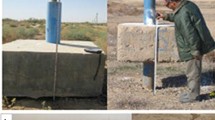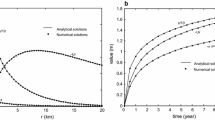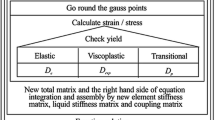Abstract
Land subsidence caused by the excessive use of groundwater resources has caused serious damage to Rafsanjan area. In this study, using finite element method, a 2D plain strain simulation of land subsidence has been conducted. A linear elastic constitutive law has been used for the simulation of the soil material skeleton. Actual water level during the analysis period has been modeled via specifying nodal water pressure at piezometer wells situation. The solution procedure consists of two parts. First, an initial static analysis is carried out in order to find initial steady-state solution for the pore pressure and stress distribution. Then, the above solution is used as initial condition for dynamic computation of consolidation equations during pumpage period. Tectonic effect has been considered as a rigid body motion. Numerical results showed that if the rate of pumpage remains constant in the future, settlement due to water withdrawal near Rafsanjan city will reach up to 110 cm by the year 2022.









Similar content being viewed by others
References
Abidin HZ, Andreas H, Gumilar I, Fukuda Y, Pohan YE, Deguchi T (2011) Land subsidence of Jakarta (Indonesia) and its relation with urban development. Nat Hazards 59:1753–1771
Adrian OG, Rudolph DL, Cherry JA (1999) The analysis of long term land subsidence near Mexico City: field investigations and predictive modeling. Water Resour Res 35:3327–3341
Barani OR, Khoei AR, Mofid M (2011) Modeling of cohesive crack growth in partially saturated porous media, a study on the permeability of cohesive fracture. Int J Fract 167:15–31
Berryman JG (1980) Confirmation of Biot’s theory. Appl Phys Lett 37:382–384
Biot MA (1941) General theory of three dimensional consolidation. J Appl Phys 12:155–164
Burbey TJ (2001) Storage coefficient revisited: is purely vertical strain a good approximation? Ground Water 39(3):458–464
Burbey TJ (2006) Three-dimensional deformation and strain induced by municipal pumping, part 2: numerical analysis. J Hydrol 330(3–4):422–434
Burbey TJ, Warner SM, Blewitt G, Bell JW, Hill E (2006) Three-dimensional deformation and strain induced by municipal pumping, part 1: analysis of field data. J Hydrol 319(1–4):123–142
Galloway DL, Burbey TJ (2011) Review: Regional land subsidence accompanying groundwater extraction. Hydrogeol J 19:1459–1486
Gambolati G, Freeze RA (1973) Mathematical simulation of the subsidence of Venice: 1. Theory. Water Resour Res 9:721–733
Gambolati G, Gatto P, Freeze RA (1974) Mathematical simulation of the subsidence of Venice: 2. Results. Water Resour Res 10:563–577
Ghaboussi J, Wilson EL (1973) Flow of compressible fluid in porous elastic media. Int J Numer Methods Eng 5:419–442
Herrera G, Fernández JA, Tomás R, Cooksley G, Mulas J (2009) Advanced interpretation of subsidence in Murcia (SE Spain) using A-DInSAR data-modelling and validation. Nat Hazards Earth Syst Sci 9:647–661
Hsieh PA (1996) Deformation-induced changes in hydraulic head during ground-water withdrawal. Ground Water 36(6):1082–1089
Julio-Miranda P, Ortız-Rodrıguez AJ, Palacio-Aponte AG, Lopez-Doncel R, Barboza-Gudino R (2012) Damage assessment associated with land subsidence in the San Luis Potosi-Soledad de Graciano Sanchez metropolitan area, Mexico, elements for risk management. Nat Hazards 64:751–765
Kazemi Azar F (2006) Modeling of groundwater flow in Rafsanjan plain and study of groundwater withdrawal effects. MSc thesis, Shahid Bahonar University, Kerman, Iran
Khamehchiyan M, Iwao Y, Saito A (1994) Land subsidence and earth fissures in Rafsanjan plain, Iran. In: Proceedings of the 7th international IAEG Congress, Lisbon, Portugal, pp 1863–1870
Khoei AR, Gharehbaghi SA, Azami AR, Tabarraie AR (2006) SUT-DAM: an integrated software environment for multi-disciplinary geotechnical engineering. Adv Eng Softw 37:728–753
Khoei AR, Barani OR, Mofid M (2011) Modeling of dynamic cohesive fracture propagation in porous saturated media. Int J Numer Anal Methods Geomech 35:1160–1184
Kihm JH, Kim JM, Song SH, Lee GS (2007) Three-dimensional numerical simulation of fully coupled groundwater flow and land deformation due to groundwater pumping in an unsaturated fluvial aquifer system. J Hydrol 335:1–14
Kim JM, Parizek RR (1999) A mathematical model for the hydraulic properties of deforming porous media. Ground Water 37(4):546–554
Lewis RW, Schrefler BA (1978) A fully coupled consolidation model of the subsidence of Venice. Water Resour Res 14:223–230
Lewis RW, Schrefler BA (1998) The finite element method in the static and dynamic deformation and consolidation of porous media. Wiley, New York
Liu CH, Pan YW, Liao JJ, Huang CT, Shoung OY (2004) Characterization of land subsidence in the Choshui River Alluvial Fan, Taiwan. Environ Geol 45:1154–1166
Mousavi SM (1999) The analysis of mutual effects between hydraulic parameters and land subsidence due to groundwater withdrawal. PhD thesis, Sharif University of Technology, Tehran, Iran
Nikdel E (1992) Report on the mechanism of movement and subsidence of Rafsanjan plain due to groundwater withdrawal and tectonics. Professional report (in Persian). Regional Water Organization, Iran
Phien-wej N, Giao PH, Nutalaya P (2006) Land subsidence in Bangkok, Thailand. Eng Geol 82:187–210
Su MB, Su CL, Chang CJ, Chen YJ (1998) A numerical model of ground deformation induced by single well pumping. Comput Geotech 23:39–60
Tabatabaee Aghda ST (2006) Prediction of land subsidence in Rafsanjan city due to groundwater withdrawal. MSc thesis, Shahid Bahonar University, Kerman, Iran
Teatini P, Ferronato M, Gambolati G, Bertoni W, Gonella M (2005) A century of land subsidence in Ravenna, Italy. Environ Geol 47:831–846
Tomás R, Herrera G, Delgado J, Lopez-Sanchez JM, Mallorquí JJ, Mulas J (2010) A ground subsidence study based on DInSAR data: calibration of soil parameters and subsidence prediction in Murcia City (Spain). Eng Geol 111:19–30
Zienkiewicz OC, Chan AHC, Pastor M, Schrefler BA, Shiomi T (1999) Computational geomechanics with special reference to earthquake engineering. Wiley, London
Acknowledgments
The authors thank Kerman Regional Water Organization, Rafsanjan Irrigation Office and Geomatic Organization of Iran for their help in supplying the data and Dr. Mashaallah Khamehchiyan for his support. The corresponding author is also grateful for the research support of the Iran National Science Foundation (INSF).
Author information
Authors and Affiliations
Corresponding author
Rights and permissions
About this article
Cite this article
Sayyaf, M., Mahdavi, M., Barani, O.R. et al. Simulation of land subsidence using finite element method: Rafsanjan plain case study. Nat Hazards 72, 309–322 (2014). https://doi.org/10.1007/s11069-013-1010-6
Received:
Accepted:
Published:
Issue Date:
DOI: https://doi.org/10.1007/s11069-013-1010-6




